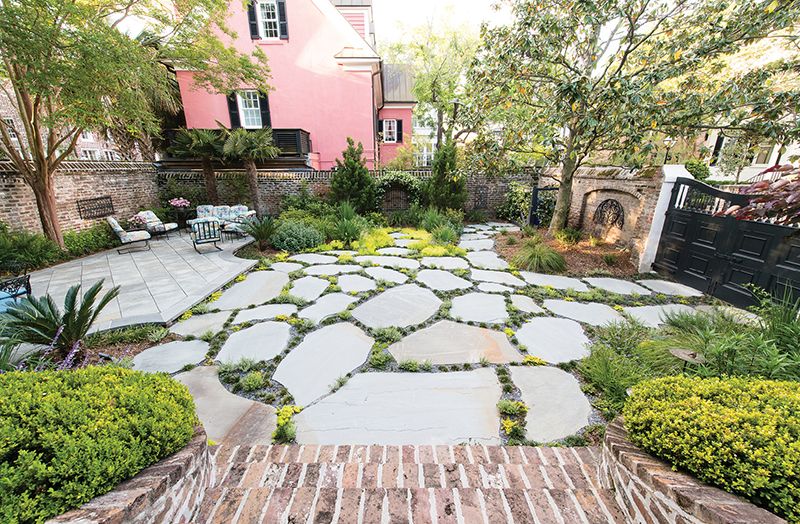This slightly wild downtown courtyard is rife with inspiration

Just off the piazza, a driveway of irregular bluestones contrasts with a formal raised terrace.
When Pooh and George Gephart purchased their King Street home, its outdoor environs were limited to a mossy brick courtyard hosting the bones of a formal garden. “They wanted to transform it into a colorful space where they could relax and entertain, but also park a car,” says Diandre Sunner of Carolina Landscape.
The local firm got creative, designing an elegant raised terrace that contrasts strikingly with the “driveway”: a mosaic of large, irregular bluestones interplanted with sun-loving ground covers and surrounded by a wild mix of grasses and perennials. Significantly, this parking area is permeable, but it’s also an enthralling garden in its own right. Here’s how to riff on the pros’ inventiveness in your landscape.

Creeping sedums soften the juncture between driveway and stairs.
Pave a space in irregular bluestones. Two-inch-thick versions are strong enough for light vehicular use—golf cart or part-time car parking, for example. Carolina Landscape filled the “joints” between them with tough, low-growing plants, plus mini slate.
Their design would translate beautifully to a pathway—“a decorative accessory on the side of your house or a woodland walk leading through your garden,” envisions Sunner, who recommends downsizing to stones an inch thick and two to three feet wide. “You could use the same materials around a fire pit or for a patio.”
A solid foundation is essential for bluestones. “We set each one on a concrete subbase to leave the joints open for topsoil and plants,” Sunner notes. Less-than-handy homeowners should call a professional.
Grow ground covers in the cracks. Carolina Landscape concentrated the hardiest plants—particularly dwarf mondo grass, but also creeping thyme and creeping Jenny—in high-traffic areas. “Sedums are more delicate and do better on the outskirts,” says Sunner.
Otherwise, they laid out the plants seemingly at random, then applied “the squint test” to make sure the shades of green were spread around appealingly.
Only have part sun? Mondo grass is still a good choice; so are ajuga and creeping phlox (though the latter can’t stand up to tires).

(Left to right) This bluestone passage is more riotous than ever when the sedum erupts into yellow bloom below a mix of grasses (such as breeze and switch) and perennials (from rosemary to coreopsis). Mini slate fortifies plantings including (from top) ‘Angelina’ and ‘John Creech’ sedums and dwarf mondo grass.
Accent the area with prairie-style plantings. “We aimed to fill the Gepharts’s garden with blooming perennials,” says Sunner; however, several natives they trialed proved a little unruly for the small space. Today, the likes of agapanthus, salvia, and euryops mingle with breeze, switch, and wire grasses. A foundation of evergreen shrubs, as well as a mature magnolia and crepe myrtles, ensure that this courtyard car park is lovely for entertaining year-round.